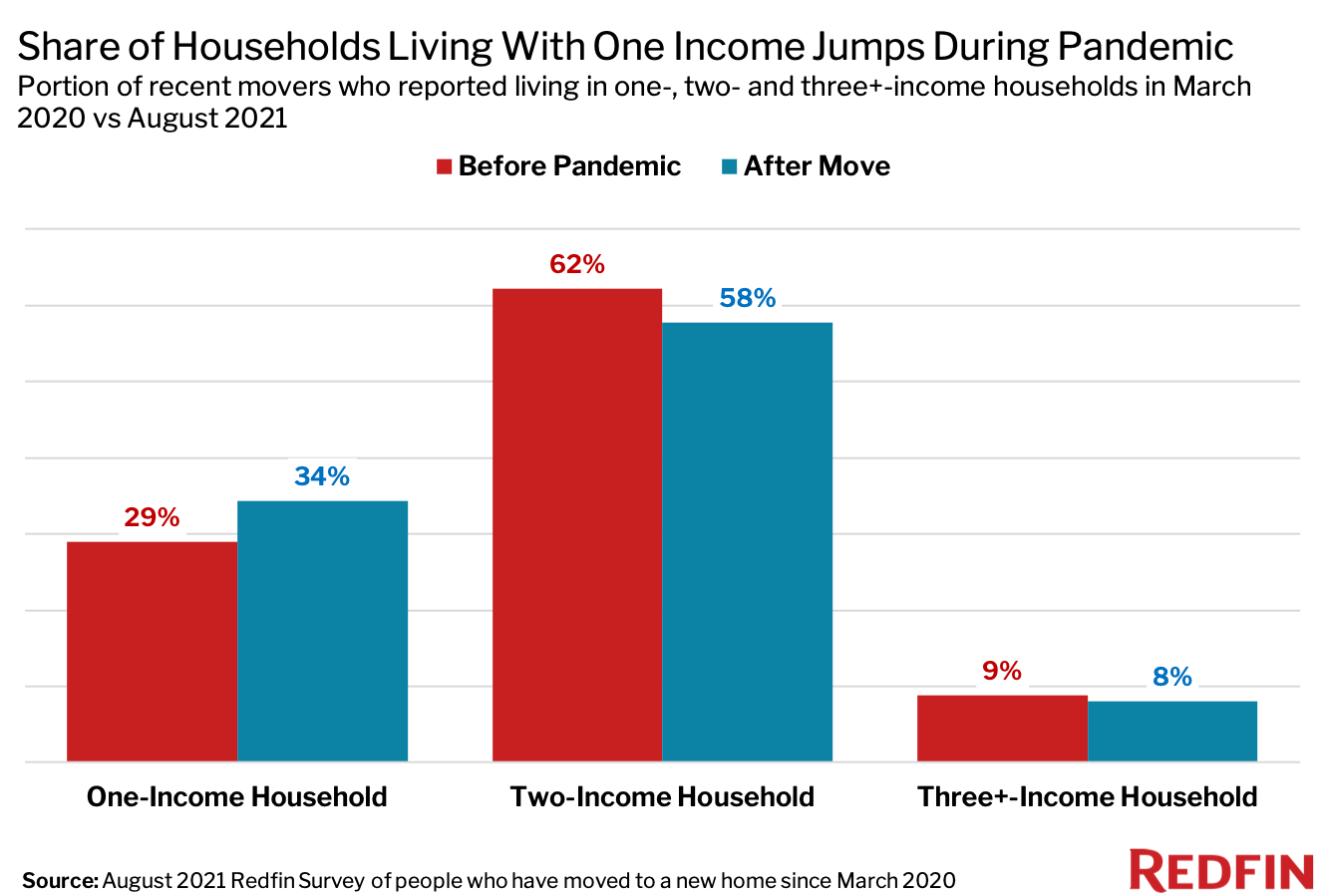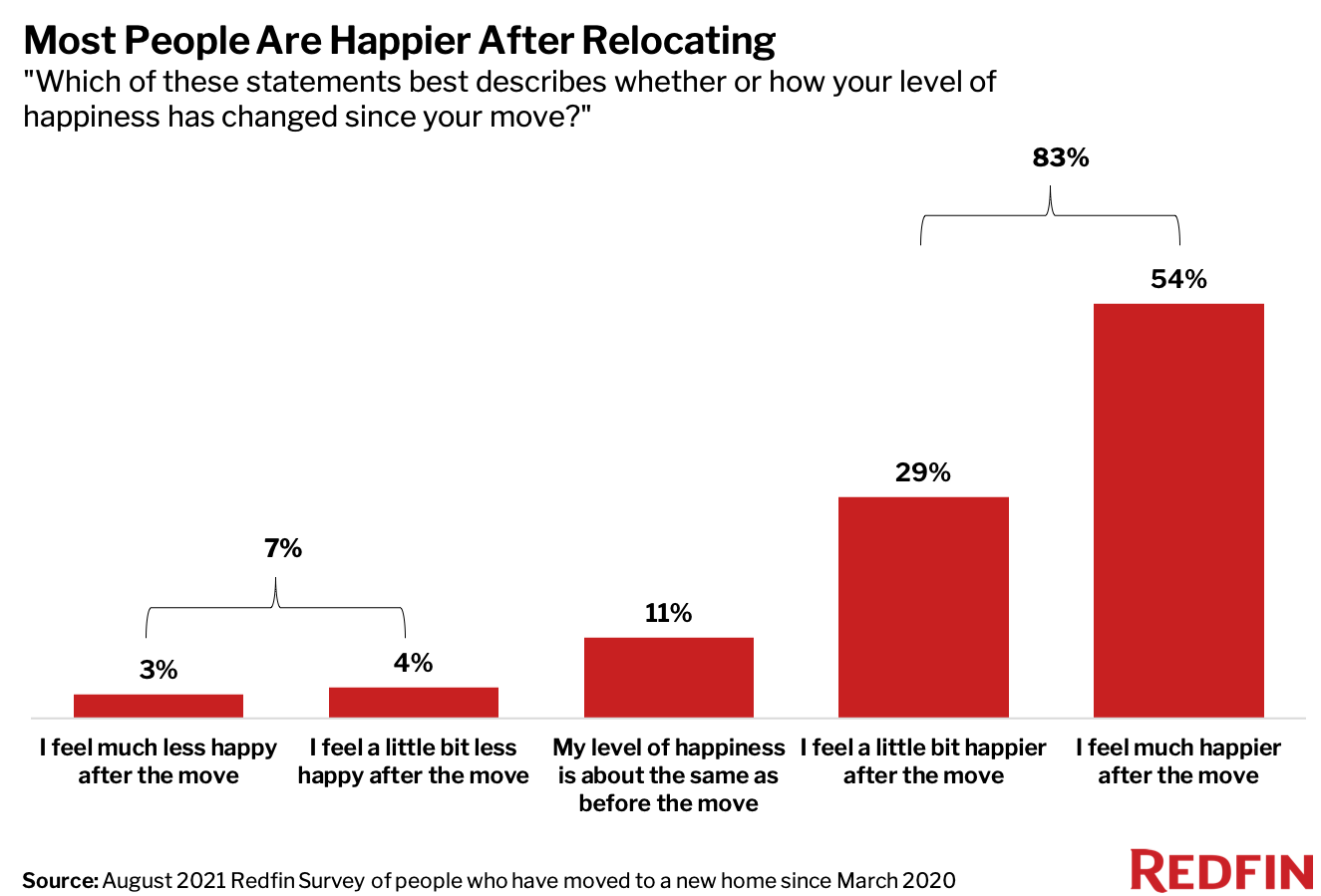More than three-quarters of respondents report feeling happier after relocating.
More than one-third (34%) of people who moved during the coronavirus pandemic live in a home where only one adult has a full-time job. By comparison, just 29% lived in a single-income household before the pandemic.
That’s according to an August 2021 Redfin survey of 1,023 U.S. residents who have moved to a new home since March 2020.
As the portion of people living in single-income households increased, the share living in dual-income households declined. Slightly more than half (58%) of the recent movers Redfin surveyed live in a home with two adults working a full-time job, down from 62% before the pandemic.
“While some people chose to move down to a single-income household, others had no choice,” Redfin Deputy Chief Economist Taylor Marr said. “Thousands of Americans lost their jobs during the pandemic, and scores of parents had to leave the workforce when daycares and schools shut down. Most workers are rethinking where their careers fall on life’s priority list.”
Remote work during the pandemic also enabled many families to relocate to more affordable places, where it’s often more feasible to live in a home with just one income. In the third quarter, 30% of Redfin.com users were looking to move to a new metro area, up from 26% before the pandemic. Among the most popular destinations were Atlanta, San Antonio and Tampa, FL—all metros with median home sale prices below the national level.
“A lot of the families that were able to move down to one income during the pandemic were high earners,” Marr said. “High earners tend to have the flexibility to work remotely, which means it’s easier for them to relocate to a more affordable place where only one adult needs to work full time. Lower-wage workers who are still required to show up in person, such as restaurant and grocery staff, are less likely to have the opportunity to move.”
A pandemic retirement boom may have also contributed to the increase in the share of single-income households. The pandemic drove more than 3 million baby boomers into early retirement, according to a study by the Federal Reserve Bank of St. Louis.
83% of Recent Movers Are Happier After Relocating
More than three-quarters (83%) of respondents said they are at least a little happier after moving. Just 7% reported being less happy and 11% said their happiness is about the same.
Austin, TX has seen an influx of out-of-towners move in during the pandemic. Many of them actually grew up in the area, left for a job, and are now able to come back and live near family, according to local Redfin real estate agent Debbie Newby.
“A majority of my buyers today are Texas natives who are thrilled to be coming home,” Newby said. “I recently worked with one young couple who had been living in the Bay Area and working in tech. The wife grew up in Austin and wanted to move back to be closer to her family members, one of whom was ill. They bought a home Near Zilker Park in January and are now working remotely. They’re ecstatic to be in Austin.”
While Austin home prices have soared well above the national median during the pandemic, the Texas metro remains more affordable than major coastal hubs including San Francisco and New York.
“Most people who move relocate to somewhere less expensive,” Marr said. “Moving tends to make people happier because it means they’re getting more bang for their buck—frequently in the form of additional space, better weather and schools, or a shorter commute to their workplace.”
Methodology
Redfin commissioned a survey of 1,023 U.S. residents who moved to a new home since March 1, 2020. The survey was fielded from Aug. 7, 2021 to Aug. 12, 2021 by research technology company Qualtrics. All 1,023 respondents answered the question about happiness, while 889 of the 1,023 respondents answered the following questions about employment in their household:
- “On March 1, 2020, how many of the adults in your home worked a full-time job?”
- “Since your move, how many of the adults in your home now work a full-time job?”
Respondents were given the following answer choices: 1, 2, 3, 4, 5 or more.

 United States
United States Canada
Canada